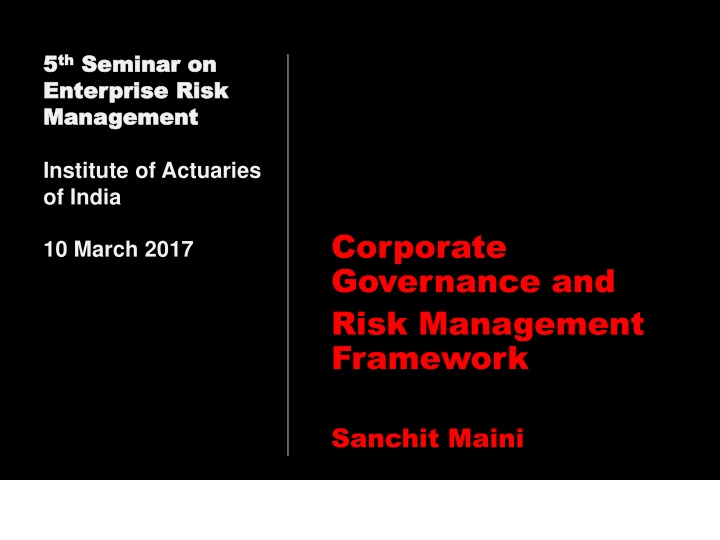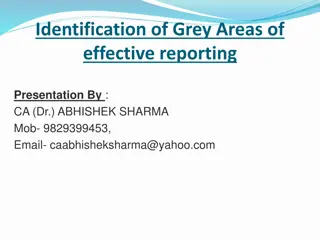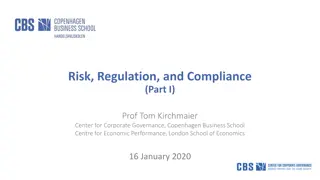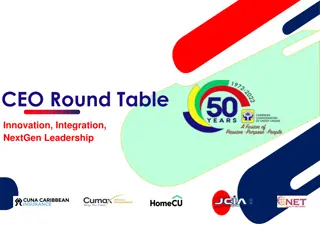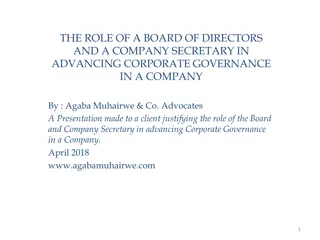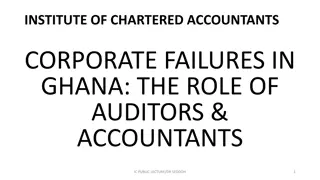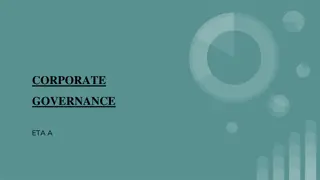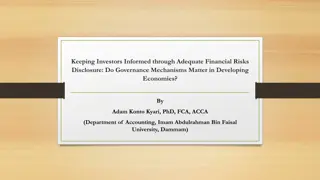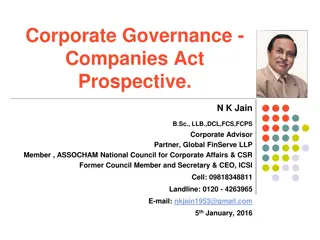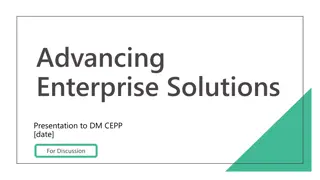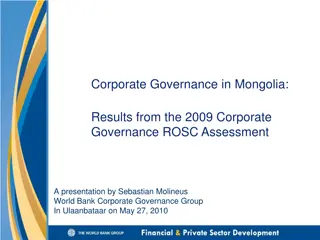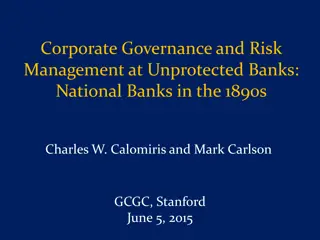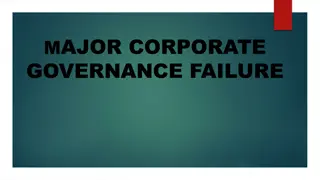Enterprise Risk Management Framework in Corporate Governance
Importance of risk management in business strategy, insurers' role in risk oversight, regulatory influences, and evolving risk management practices like the Three Lines of Defence model and the CRO role. Understand the significance of risk-based capital, internal models, and the interplay with corporate governance structures
Download Presentation

Please find below an Image/Link to download the presentation.
The content on the website is provided AS IS for your information and personal use only. It may not be sold, licensed, or shared on other websites without obtaining consent from the author.If you encounter any issues during the download, it is possible that the publisher has removed the file from their server.
You are allowed to download the files provided on this website for personal or commercial use, subject to the condition that they are used lawfully. All files are the property of their respective owners.
The content on the website is provided AS IS for your information and personal use only. It may not be sold, licensed, or shared on other websites without obtaining consent from the author.
E N D
Presentation Transcript
5 5th Enterprise Risk Enterprise Risk Management Management thSeminar on Seminar on Institute of Actuaries of India Corporate Governance and Risk Management Framework 10 March 2017 Sanchit Maini
Contents Introduction 1 2 Governance 3 Risk Management Framework 4 Outlook 2
Why is Risk Management Gaining Prominence? 1 It makes good business sense Sharpens strategy: what you can and cannot do as a business Focus on what matters: agreed set of metrics Define what outcomes are acceptable: focus on targets & variability (supports the development of risk appetite) Focus on management actions to make business outcomes less variable, more predictable and boring! 2 Insurers are in the business of managing risk Risk taking, risk oversight and assurance separated Risk management allows common framework to be applied across risks and enterprise wide Capital as a currency for risk and its allowance in value management allows a holistic approach 3 Regulatory developments another driving force Corporate governance, customer protection and risk based prudential standards 5
What Influences Are We Seeing on Risk Management Practices? 1 Three lines of defence model Separation of risk taking, risk oversight and independent assurance Effectiveness varies a lot, strong risk culture critical success factor 2 CRO role is gaining prominence European insurers and increasingly Asian insurers have raised the CRO role s profile and made it part of the Executive Committee Head of the second line function: Covering risk and compliance Solvency II defines controls functions: actuarial, risk, compliance and audit 3 Risk based capital and use of internal models Need for validation of internal models Use Test Own Risk and Solvency Assessment 6
corporate governance. a set of relationships between a company s management, its board, its shareholders and other stakeholders which provides the structure through which the objectives of the company are set, and the means of attaining those objectives and monitoring performance. It helps define the way authority and responsibility are allocated and how corporate decisions are made 7
Key Governance Themes 1 2 function effectiveness 3 4 5 6 Governance increasingly structured around the three lines of defence model Insurance regulators adopting IAIS ICPs. ICP 7: corporate governance framework. ICP 8 risk management, internal controls and control Appropriate Board composition: NEDs / INEDs, breadth of experience Risk and Audit Committee with individual mandates INEDs to chair both Risk and Audit Co s Control functions and key persons Strengthening risk culture 8
Governance Map illustrative First Line Second Line Third Line Board of Directors Remuneration Co. Nomination Co. Risk Co. Audit Co. Chief Executive Product Approval Co. Risk Co. Internal Audit Insurance Risk Co. Credit Risk Co. ALCO Information & Technology Co. Investment Co. Technical Actuarial Co. Technical Oversight Co. Operational Risk Co. Emerging Risk Co. 9
Regulatory Changes in Asia (ex Solvency/ Actuarial) INDIA MALAYSIA SINGAPORE THAILAND VIETNAM Korea China Key Themes: Enhanced Due Diligence High-Risk Customers / PEPs Sanctioned Countries KYC Beneficial Owners India Hong Kong Vietnam Taiwan Philippines Thailand Malaysia Singapore Indonesia *For the last 12 months. Regulatory Themes are based on the understanding of the scope and coverage of the relevant regulatory changes or developments identified for the period, other regulatory themes pertained to taxation, solvency, actuarial, etc. not represented here 10
Regulatory Developments in Asia Pacific (1/3) Australia Life Insurance Cap on upfront commission (as per cent of premiums): 80% from Jul 2016, 70% from Jul 2017 and 60% from Jul 2018. Renewal commission cap of 20% Two year commission clawback period: 100% of FYC in case policy lapses in 1st policy year, 60% in case policy lapses in 2nd year Ban on volume based payments being proposed Health Insurance From July 2015 the regulator of health insurance industry changed from PHIAC (Private Health Insurance Administration Council) to APRA (Australian Prudential Regulatory Authority) Insurers are concerned on risk management function becoming mandatory and the capital standards being strengthened China Introduction of C-ROSS from Jan 2016 Risk oriented solvency regime using the three pillar approach of quantitative risk assessment, qualitative risk assessment and disclosure requirements Aligns the financial reporting system with the solvency system hence not fully economic Hong Kong Establishment of Independent Insurance Authority in phases RBC to be developed along the three pillar structure, not likely before 2020 Conduct guidance: GN15 and GN16 covering product design, commission structure, marketing literature, illustrations GN10 covering Corporate Governance Impact from Mainland China owing to capital restrictions however MCH sales in HK continue to be strong 11 Source: KPMG
Regulatory Developments in Asia Pacific (2/3) Singapore ORSAs implemented from Dec 2015 RBC2 consultations continue with QIS2 released, MAS looking to adopt by 2018/19 Will impact insurers product, investment and capital strategy MAS continuing to look at Board to set tone at the top, perform stewardship role, and exercise effective oversight: fair treatment of customers, foster strong risk culture by defining risk objectives, promoting risk awareness and translating it to all aspects of business MAS set up a FinTech and Innovation Group in 2015: Regulatory sandbox announced FAIR: Financial Advisory Industry Review includes several aspects: higher CPD for advisors, more stringent licensing conditions for financial advisory firms, new minimum base capital requirements, balanced scorecard for remuneration, direct channel for simple insurance products, web aggregator for enhanced comparability Malaysia BNM approval required before dividend distribution to shareholders to ensure healthy CAR ratios LIFE Framework: Life Insurance and Family Takaful: aims to improve distribution diversification, gradual removal of limits on costs, to promote product innovation, strengthened market conduct to enhance customer protection Indonesia New reinsurance regulations (minimum domestic ceding) Temporary relaxation of capital requirements: option to use amortised cost as the valuation basis for debt, reduction in minimum RBC requirement of 50 per cent provided RBC ratio of 120% Marketing and approval of insurance: OJK s prior approval 12 Source: KPMG
Regulatory Developments in Asia Pacific (3/3) India FDI increase to 49% from 26% Reinsurers allowed to set up branches including Lloyds Insurers can issue capital other than equity shares Expense management including requirements on submission of expense allocation across product segments Corporate agents allowed to distribute three insurers products, previously were restricted to one of each life/health/non-life Taiwan Peer review of appointed actuary s report every 3 years ORSA submission commencing in 2016 Possibility of new RBC measurement as a standardised approximation to economic capital being discussed in the industry Thailand RBC changes being considered: QIS during 2016, transition period during which Op Risk charge to be introduced, focus on ORSA. At some point OIC will increase confidence level from 95 per cent VaR to 99.5 per cent VaR 13 Source: KPMG
IAISSupervisory Framework (1/2) IAIS is developing a ComFrame to supervise internationally active insurers (IAIGs) ComFrame or Common Framework includes Insurance Capital Standards (ICS) - global capital standard for increasingly globalised insurance market Tier Tier Legal Entity Legal Entity Group Group IAIG IAIG G G- -SII SII 1 * Insurance Core Principles (ICPs) ICPs applicable to LEs * ICPs applicable to LEs and Groups 2 Com Frame 3 G-SII package ComFrame further builds on ICPs covering capital requirements for IAIGs, qualitative requirements for IAIGs, scope of group-wide supervision, requirements for supervisors, crisis management and resolution G-SII: Global Systemically Important Insurers published by Financial Stability Board www.fsb.org IAIG: Internationally Active Insurance Group published by the International Association of Insurance Supervisors 14
IAIS Supervisory Framework (2/2) ICS includes a G-SII package Basic Capital Requirement HLA International Capital Standard In development and annual field testing Intended to produce a consistent global measure of capital Current calibration 1-in-200 VaR Version 1 reporting in 2017 Version 2 in 2019 to have greater comparability, may allow internal models IAIS s ultimate aim is to have a single ICS with common methodology globally Higher Loss Absorbency Initial form concluded in Oct 2015 Additional capital for G-SIIs to cover systemic risk BCR+33% (uplift for G- SII)+HLA Finalised in 2014 with confidential reporting in 2015 Factor based approach to allow global comparability and ensure minimum capital requirements To be replaced by ICS eventually Firm Firm G-SII List List 9: Aegon, Allianz, AIG Aviva, Axa, MetLife, Ping An, Prudential Financial Prudential plc c.50 ICS ICS BCR BCR HLA HLA G-SII package IAIG Non-IAIG 15 Source: IAIS, EY
APRA CPS220 Risk Management Requirement of Boards forms forms a view of risk culture a view of risk culture in the institution, and the in the institution, and the extent to which that culture supports the ability of the extent to which that culture supports the ability of the institution to institution to operate consistently within its risk appetite operate consistently within its risk appetite, , identifies any identifies any desirable changes to risk culture desirable changes to risk culture and ensures the and ensures the institution takes steps to institution takes steps to address those changes address those changes 16 Source: APRA
APRA on undesirable behaviours pursuing short-term financial interests, including personal interests, with little or no consideration of customer interests; observing the letter of relevant law and regulation, while contravening the spirit of those laws and regulations; treating risk management processes and/or controls as inconveniences which can be disregarded when expedient to do so; poorly defining management accountabilities for risks; failing to reward good risk management and/or apply consequences for poor management of risks; senior executives and/or directors failing to take timely actions to mitigate significant risks; concealing problems, rather than resolving the underlying causes of the problems; and failing to challenge the status quo and consider alternative viewpoints, resulting in a false sense of security and risk blind spots. 17 Source: APRA
risk management framework. 18
Risk Management Building Blocks Roles & Roles & Responsibilities Responsibilities Governance Governance Risk Policies Risk Policies Culture Culture Risk Risk- -based based Decision Decision Making Making Risk Appetite Risk Appetite Identification Identification Risk Cycle Risk Cycle Monitoring Monitoring & Reporting & Reporting Measurement Measurement Internal Model Internal Model Technology Technology 19
Risk Framework Risk Framework B A Risk Governance Risk Processes Risk Appetite Risk Policies Risk Appetite Statements and aggregate limits Risk Management Cycle & ORSA Description of Risk Governance Arrangements Examples: Credit Risk, Insurance Risk, Liquidity Risk, Market Risk and Operational Risk Policies Product Policy In-Force Management Policy Internal Model Policy (IM Companies only) Model Risk Policy, Compliance, Customer, Investment, C Approved Limits by risk type Risk-Based Decision Making Financial & Operational Incidents Procedure Risk Definition & Categorization Risk Culture Model Governance Operational Standards and Risk Management Guidance Notes 20
Risk Appetiteexample A Earnings Volatility EV Operating Profit IFRS Operating Profit Capital Liquidity Liquidity Coverage Ratio Solvency II regulatory capital Internal Economic Capital Group Group Limits Risks significant at Group level Operational Risk Level 2 Capital Local solvency Internal Economic Capital Earnings Volatility EV OP, VNB Liquidity Liquidity Coverage Ratio Operational Risk # of incidents Cumulative losses Operational Risk Group red/amber flags Local Local Limits By Risk Type (eg Counterparty Risk, Interest Rate Risk, Equity Risk) 1-in-x fall Board decision to approve the x Limits reset at each planning cycle Risk budgets to local businesses Regular limits monitoring. Frequency varying by momentum of individual risk driver High level agreement of management actions at defined levels [Link with ORSA] 21
Risk Policies B 1 Ownership should be clearly established Annual certification process with risk function providing oversight for first line policies. Audit to provide process assurance 2 3 Operating Standards to underpin the Policies 4 Recent regulatory focus on Model Risk Policy. IAA recently released ISAP on Model Risk 22
Risk Based Decision Making Processes 1 C Product development 2 3 4 5 6 Risk Transfer Strategic Decisions/ M&A Strategic Asset Allocation / Investments Capital Management Business Planning 23
outlook. 24
Role of Risk Across Processes 25 Source: EY
8 Key Success Factors for Risk Functions 1 5 6 Early intervention Reputational risk management 2 Score of Wins by Risk Function Risk Appetite 3 Keep abreast of regulatory developments 7 Skills of a risk manager 8 4 Know the competition Strong risk culture 26
Most institutions are still grappling with how best to clearly articulate what type of risk culture they aspire to, identify any specific weaknesses in their current risk culture, and how they most effectively address those weaknesses. It is therefore critical that this attention on risk culture be sustained 27 Source: APRA
